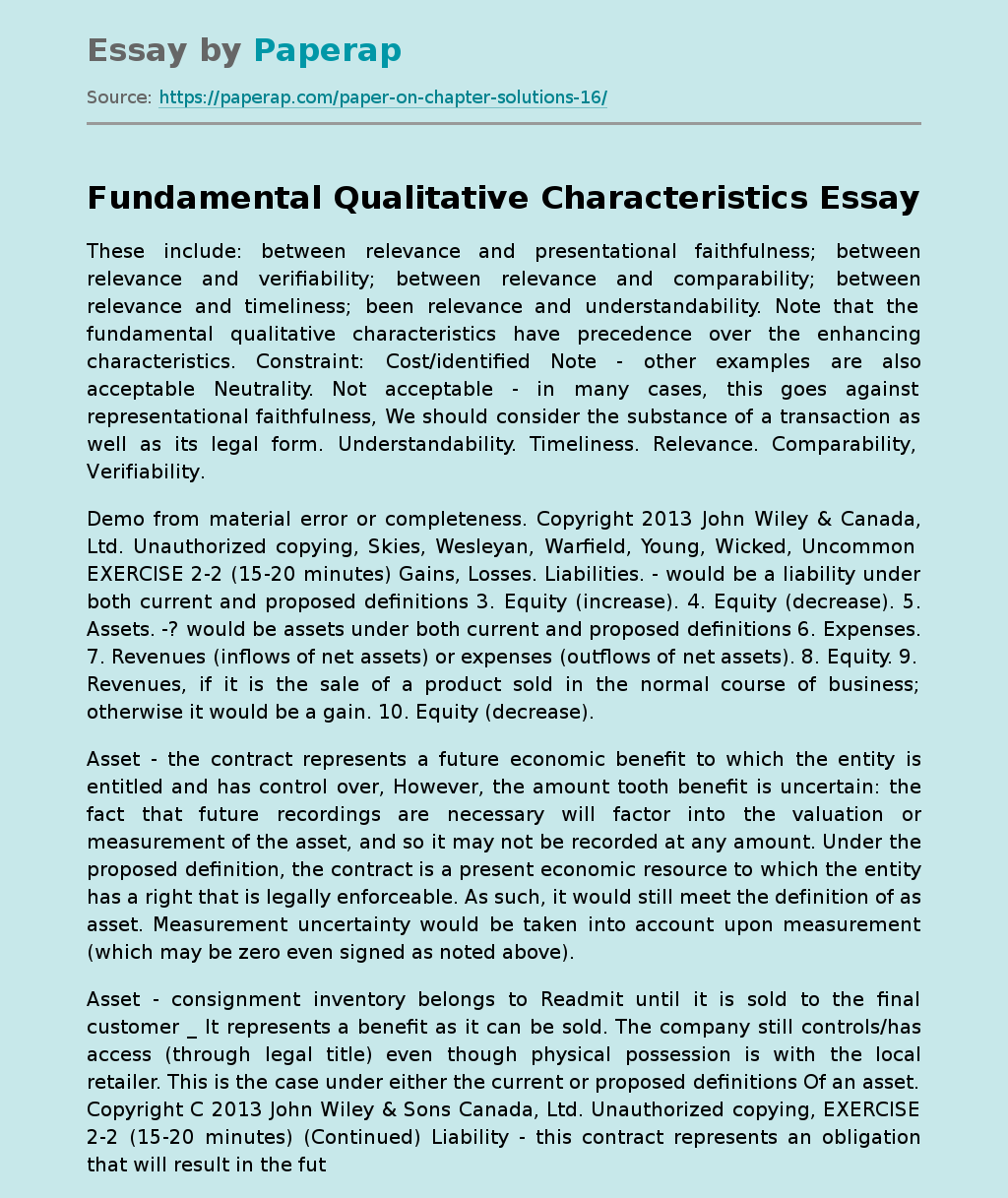Fundamental Qualitative Characteristics
These include: between relevance and presentational faithfulness; between relevance and verifiability; between relevance and comparability; between relevance and timeliness; been relevance and understandability. Note that the fundamental qualitative characteristics have precedence over the enhancing characteristics. Constraint: Cost/identified Note – other examples are also acceptable Neutrality. Not acceptable – in many cases, this goes against representational faithfulness, We should consider the substance of a transaction as well as its legal form. Understandability. Timeliness. Relevance. Comparability, Verifiability.
Demo from material error or completeness. Copyright 2013 John Wiley & Canada, Ltd.
Unauthorized copying, Skies, Wesleyan, Warfield, Young, Wicked, Uncommon EXERCISE 2-2 (15-20 minutes) Gains, Losses. Liabilities. – would be a liability under both current and proposed definitions 3. Equity (increase). 4. Equity (decrease). 5. Assets. -? would be assets under both current and proposed definitions 6. Expenses. 7. Revenues (inflows of net assets) or expenses (outflows of net assets). 8. Equity. 9. Revenues, if it is the sale of a product sold in the normal course of business; otherwise it would be a gain.
10. Equity (decrease).
Asset – the contract represents a future economic benefit to which the entity is entitled and has control over, However, the amount tooth benefit is uncertain: the fact that future recordings are necessary will factor into the valuation or measurement of the asset, and so it may not be recorded at any amount. Under the proposed definition, the contract is a present economic resource to which the entity has a right that is legally enforceable. As such, it would still meet the definition of as asset. Measurement uncertainty would be taken into account upon measurement (which may be zero even signed as noted above).
Asset – consignment inventory belongs to Readmit until it is sold to the final customer _ It represents a benefit as it can be sold. The company still controls/has access (through legal title) even though physical possession is with the local retailer. This is the case under either the current or proposed definitions Of an asset. Copyright C 2013 John Wiley & Sons Canada, Ltd. Unauthorized copying, EXERCISE 2-2 (15-20 minutes) (Continued) Liability – this contract represents an obligation that will result in the future outflow of resources, subject to the sale of the recordings.
However, the renovation that Obligates the company – sale of recordings – has to occur. At that point, a liability would exist. Under the proposed definition, the contract represents an unconditional requirement and an obligation that is presently enforceable, and so would meet the definition of a liability in either case. Under the proposed definition, the uncertainty would be taken into account on measurement. 2-5 Copyright C 2013 John Wiley & Sons Canada, Ltd. Unauthorized copying, EXERCISE 2-3 (15-20 minutes) 4. Matching 8. Historical cost 10. Full disclosure 7.
Going concern 2. Control 1. Economic entity S. Periodicity 9. Fair value 3. Revenue recognition and realization 6. Monetary unit EXERCISE 2-4 (20-25 minutes) 14, Monetary unit Full disclosure Historical cost and matching Going concern Historical cost Revenue recognition and realization disclosure Economic entity Periodicity Matching/fair value Matching EXERCISE 2-5 (25-30 minutes) (a) A conceptual framework is useful for standard setters since having an established body of concepts and objectives helps them to develop additional useful and consistent standards.
This results in a coherent set of standards and rules that are built upon the same inundation. An understanding of the underlying concepts helps the preparer and the auditor ensure consistent and meaningful application of the principles. Such a framework also increases the financial statement user’s understanding of, and provides confidence in, financial reporting. It also enhances comparability Of different companies’ financial statements. (b) Foundational principle or characteristic violated: 1. Periodicity; relevance (predictive and feedback value); timeliness 2. Historical cost; verifiability; relevance 3.
Fundamental Qualitative Characteristics. (2018, May 07). Retrieved from https://paperap.com/paper-on-chapter-solutions-16/

